Jan 2016
Short cut
31/01/16 22:13
Someone either overshot the lane or tried to cut the corner from Far Heightside. It's far too boggy to do that!
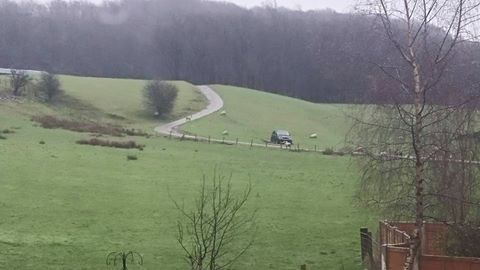
Picture courtesy of George Kirk.

Picture courtesy of George Kirk.
Preparation is everything
28/01/16 19:01
After a busy few weeks at work I managed to take a day off and scurried down to the National Archives. I had originally planned to tackle the 1939 Register for my area but revised this when FMP announced that this would be free to subscribers in February. By the time I found this out it was too late to preorder any of the material specific to Springhill (of which there is lots of juicy Chancery stuff, litigious lot they were). Plan B therefore was to extend my coverage of the 1910 Valuation, which currently has only been transcribed for the immediate Springhill area.
Lesson number one: if you are going to look at something which requires access to the Reading Room, make sure your readers' ticked is up to date. Mine wasn't.
Having realised that I didn't have any proof of address, I decided not to waste time on the e-learning about not using pencils with rubbers and headed back to the open area. No matter, I will make a start on the 1939 after all.
Find My Past website was down.
In the event I found the Register for births as Sion Baptist ('the Particular Baptist Church at Cloughfold' - it helps to know the history of the place) and had great fun transcribing these. I managed about 2/3 of them in the time available. Yes, they are available on Ancestry and the Genealogist but having got to Kew it was a shame to waste the time and the weather was too poor for the gardens.
So for next time:
Complete the e-learning and register for a ticket before leaving home
Remember to preorder the documents in advance so I finally can find out the settlement of Mary Ann Patrick's will and the custody arrangements for her nieces in their minority.
Take the documents necessary for the reader card
Decide in advance what computer-based resource I will use if there is a gap between fetching documents from the reading room.
Lesson number one: if you are going to look at something which requires access to the Reading Room, make sure your readers' ticked is up to date. Mine wasn't.
Having realised that I didn't have any proof of address, I decided not to waste time on the e-learning about not using pencils with rubbers and headed back to the open area. No matter, I will make a start on the 1939 after all.
Find My Past website was down.
In the event I found the Register for births as Sion Baptist ('the Particular Baptist Church at Cloughfold' - it helps to know the history of the place) and had great fun transcribing these. I managed about 2/3 of them in the time available. Yes, they are available on Ancestry and the Genealogist but having got to Kew it was a shame to waste the time and the weather was too poor for the gardens.
So for next time:
Complete the e-learning and register for a ticket before leaving home
Remember to preorder the documents in advance so I finally can find out the settlement of Mary Ann Patrick's will and the custody arrangements for her nieces in their minority.
Take the documents necessary for the reader card
Decide in advance what computer-based resource I will use if there is a gap between fetching documents from the reading room.
Found in the Paddock...
15/01/16 23:35
Was wandering around the old Paddock the other week looking for plants in flower as part of the BSBI New Year flower hunt. Didn't find any flowers but did find this interesting stone slab over a small passage apparently leading underground.
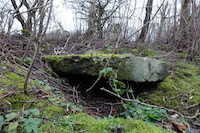
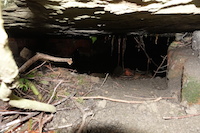
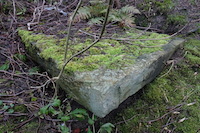
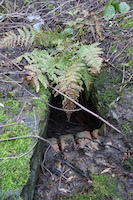
But why is it there? The general area is extensively mined and quarried but no workings are known this low down the hill and most ventilation shafts were not protected until recently. It is too shallow to admit anyone. There are some springs which have similar coverings but no water has been seen emerging from it and the amount of rain recently is such that many long dormant springs have flowed this last month.
So I am left with no idea…




But why is it there? The general area is extensively mined and quarried but no workings are known this low down the hill and most ventilation shafts were not protected until recently. It is too shallow to admit anyone. There are some springs which have similar coverings but no water has been seen emerging from it and the amount of rain recently is such that many long dormant springs have flowed this last month.
So I am left with no idea…
Surname and One Place Studies: do they marry?
08/01/16 22:09
As this study has developed there have been a number of surnames which have recurred over time and whose bearers have had profound influence on the place. These have fallen into two main groups:
Firstly, there are families who seem to have a pretty constant presence in the area and whose members have exerted influence over time. The Bridge/Briggs family weaves its way through the study from being one of the earliest residents on deforestation in 1507 to having members interred in Sion graveyard in 1858 and on to today. Howarth/Haworth is another contender as are Ormerod and Ashworth.
There are also a number of surnames which are particularly associated with the wider Rossendale area - the Rossendale Family History and Heraldry Society list a number including Ormerod (again!), Taylor, Rothwell, Pickup, Duckworth, Tattersall, Trickett, Whittaker and of course Ashworth.
A third aspect is the range and relative frequency of surnames in a point of time and how they change over time. What is the relative proportion of Ashworths to Ormerods in, say, 1841 and 1911? Does that differ from their distributions in C17 on deforestation?
So I have decided to dip my toe into the world of surname studies and how they relate to one-place studies. I have no intention of undertaking a traditional 'all instances, worldwide' type of study as the distribution of Ashworths or trend in BMDs of Ormerods elsewhere doesn't appeal. Instead I hope, over time, to look at three areas:
Firstly the Bridge name in Deadwenclough, the old administrative area which includes Springhill. I have chosen Bridge because of their presence in the early court rolls and Deadwenclough because that is the area to which these rolls refer.
Secondly, and this may be brave (for which read,stupid) I want to try and get my head round the local Ashworth families and their influence on the area. It is often said that there is an Ashworth under every stone round here and that when the local FH society is contacted for help with Ashworths they advise choosing another name. This will not be finished soon (for which read, ever).
Thirdly, to look at relative frequency of names in the area at two distinct parts of time. This is still to be fleshed out but will probably involve comparison with records, probably from a variety of sources, in the first half of C17 with those at a C19 point, possibly the 1841 census. Migration studies would be interesting to look at too but might be tricky.
To this end I have registered the first two with the Surname Society and enrolled on the Pharos One-Name Studies course for a crash course to get up to speed with this new way of looking at data. I won't be GOONS-registering them as the focus is on one-place rather than one-name studies - Briggs/Bridge is already registered anyway.
Firstly, there are families who seem to have a pretty constant presence in the area and whose members have exerted influence over time. The Bridge/Briggs family weaves its way through the study from being one of the earliest residents on deforestation in 1507 to having members interred in Sion graveyard in 1858 and on to today. Howarth/Haworth is another contender as are Ormerod and Ashworth.
There are also a number of surnames which are particularly associated with the wider Rossendale area - the Rossendale Family History and Heraldry Society list a number including Ormerod (again!), Taylor, Rothwell, Pickup, Duckworth, Tattersall, Trickett, Whittaker and of course Ashworth.
A third aspect is the range and relative frequency of surnames in a point of time and how they change over time. What is the relative proportion of Ashworths to Ormerods in, say, 1841 and 1911? Does that differ from their distributions in C17 on deforestation?
So I have decided to dip my toe into the world of surname studies and how they relate to one-place studies. I have no intention of undertaking a traditional 'all instances, worldwide' type of study as the distribution of Ashworths or trend in BMDs of Ormerods elsewhere doesn't appeal. Instead I hope, over time, to look at three areas:
Firstly the Bridge name in Deadwenclough, the old administrative area which includes Springhill. I have chosen Bridge because of their presence in the early court rolls and Deadwenclough because that is the area to which these rolls refer.
Secondly, and this may be brave (for which read,stupid) I want to try and get my head round the local Ashworth families and their influence on the area. It is often said that there is an Ashworth under every stone round here and that when the local FH society is contacted for help with Ashworths they advise choosing another name. This will not be finished soon (for which read, ever).
Thirdly, to look at relative frequency of names in the area at two distinct parts of time. This is still to be fleshed out but will probably involve comparison with records, probably from a variety of sources, in the first half of C17 with those at a C19 point, possibly the 1841 census. Migration studies would be interesting to look at too but might be tricky.
To this end I have registered the first two with the Surname Society and enrolled on the Pharos One-Name Studies course for a crash course to get up to speed with this new way of looking at data. I won't be GOONS-registering them as the focus is on one-place rather than one-name studies - Briggs/Bridge is already registered anyway.
Achievements and ambitions
01/01/16 13:30
As 2016 begins its time to reflect on the progress of the study over the last year and to set some goals for next.
I began 2015 with only one clear ambition for the One-Place study and that was to complete my 52 residents in 52 weeks challenge. this is a variant on Amy Johnstone Crow's '52 ancestors in 52 weeks' blogging challenge which I adapted to cover 52 people with some connection with Springhill, though I'd be lying if I claimed they all actually lived here. The summary can be found in the Residents page.
Despite having no other clear ambitions for 2015 I managed to:
So what for 2016?
1. Take a decision (probably pretty soon) about whether to increase the study area to that covered by the old vaccary of Deadwenclough. As I am interested in following up a number of C16-18 leads this makes sense as the records refer to this administrative area. It will also allow me to look at areas of local history beyond the immediate Springhill area. I have already done this to some extent, primarily to include the Friends' Burial Ground. The downside is that it will mean re-doing census, trade directories and other extractions and greatly increase the scope of the project. That won't be finished this year.
2. Get to grips with the 1939 Register for my area, however defined. Initial forays haven't been encouraging, with my grandfather's known household transcription having the incorrect house name and village and my uncle who should have been redacted but wasn't.
3. Complete the April A-Z blogging challenge. I am hoping to do this by looking at areas of legislation related to my study, hopefully going beyond the obvious at times. Some of the connections may be a little tenuous.
4. Further improve my competence with C17 writing. To date this has largely been with one hand and I'm aware that other hands might be more complex.
6. Having obtained my father's Y-DNA and my mit DNA, the next stage is understanding the results in greater depth.
7.Whilst I will remain a One-Placer, there are a couple of surnames which recur time and again during these studies, Ashworth and Bridge being the main culprits. I am planning to start a limited surname study into those names in this area (Bridge is already GOON-registered and I don't want to study beyond the immediate area) and plan to have an online presence for at least one of these in 2016. Whether that is on this site or linked to it has still to be decided.
8. I have long meant to look at the history of non-conformity in the area in the C17 and early C18 centuries and the circumstances which made it take hold here. This will be the year that I finally begin to get on with it. It will probably be mainly secondary sources this year to try and establish a background.
9. I will look at Dear Myrtle's get organised project but can't promise to complete it every week. A good tidy up is long overdue but this may not be the year
10. Finally, and the one which may scupper the others, I will take a serious look at doing the Oxford Local History Course this year. This has been on my wish list for some time and may be achievable this year…if I let most of the others drop…
I began 2015 with only one clear ambition for the One-Place study and that was to complete my 52 residents in 52 weeks challenge. this is a variant on Amy Johnstone Crow's '52 ancestors in 52 weeks' blogging challenge which I adapted to cover 52 people with some connection with Springhill, though I'd be lying if I claimed they all actually lived here. The summary can be found in the Residents page.
Despite having no other clear ambitions for 2015 I managed to:
- have an article on my one-place study published in Family Tree magazine. As my expertise is anaesthesia and medical education I never dreamed of publishing in the popular history press.
- deliver a presentation on the influence of the textile industry on migration in my area at the Society of One Place Studies conference in Ipswich in November. I learned lots from doing it and still have lots to learn but would love to do so again if ever asked.
- improve both my competence and confidence with C17 handwriting, thanks to the generous input of Mistress Agnes.
- persuade my father, the last male in our family line, to have his Y-DNA analysed. This won't help my One-Place Study but I'm pleased he agreed.
So what for 2016?
1. Take a decision (probably pretty soon) about whether to increase the study area to that covered by the old vaccary of Deadwenclough. As I am interested in following up a number of C16-18 leads this makes sense as the records refer to this administrative area. It will also allow me to look at areas of local history beyond the immediate Springhill area. I have already done this to some extent, primarily to include the Friends' Burial Ground. The downside is that it will mean re-doing census, trade directories and other extractions and greatly increase the scope of the project. That won't be finished this year.
2. Get to grips with the 1939 Register for my area, however defined. Initial forays haven't been encouraging, with my grandfather's known household transcription having the incorrect house name and village and my uncle who should have been redacted but wasn't.
3. Complete the April A-Z blogging challenge. I am hoping to do this by looking at areas of legislation related to my study, hopefully going beyond the obvious at times. Some of the connections may be a little tenuous.
4. Further improve my competence with C17 writing. To date this has largely been with one hand and I'm aware that other hands might be more complex.
6. Having obtained my father's Y-DNA and my mit DNA, the next stage is understanding the results in greater depth.
7.Whilst I will remain a One-Placer, there are a couple of surnames which recur time and again during these studies, Ashworth and Bridge being the main culprits. I am planning to start a limited surname study into those names in this area (Bridge is already GOON-registered and I don't want to study beyond the immediate area) and plan to have an online presence for at least one of these in 2016. Whether that is on this site or linked to it has still to be decided.
8. I have long meant to look at the history of non-conformity in the area in the C17 and early C18 centuries and the circumstances which made it take hold here. This will be the year that I finally begin to get on with it. It will probably be mainly secondary sources this year to try and establish a background.
9. I will look at Dear Myrtle's get organised project but can't promise to complete it every week. A good tidy up is long overdue but this may not be the year
10. Finally, and the one which may scupper the others, I will take a serious look at doing the Oxford Local History Course this year. This has been on my wish list for some time and may be achievable this year…if I let most of the others drop…



